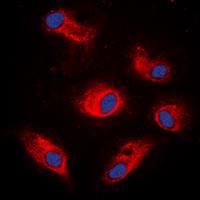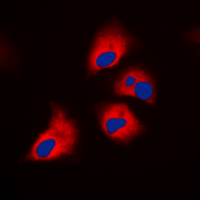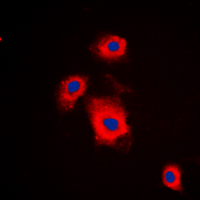p70 S6K antibody
GTX107562
ApplicationsImmunoFluorescence, Western Blot, ImmunoCytoChemistry, ImmunoHistoChemistry, ImmunoHistoChemistry Paraffin
Product group Antibodies
TargetRPS6KB1
Overview
- SupplierGeneTex
- Product Namep70 S6K antibody
- Delivery Days Customer9
- Application Supplier NoteWB: 1:500-1:3000. ICC/IF: 1:100-1:1000. IHC-P: 1:100-1:1000. *Optimal dilutions/concentrations should be determined by the researcher.Not tested in other applications.
- ApplicationsImmunoFluorescence, Western Blot, ImmunoCytoChemistry, ImmunoHistoChemistry, ImmunoHistoChemistry Paraffin
- CertificationResearch Use Only
- ClonalityPolyclonal
- Concentration0.7 mg/ml
- ConjugateUnconjugated
- Gene ID6198
- Target nameRPS6KB1
- Target descriptionribosomal protein S6 kinase B1
- Target synonymsPS6K, S6K, S6K-beta-1, S6K1, STK14A, p70 S6KA, p70(S6K)-alpha, p70-S6K, p70-alpha, ribosomal protein S6 kinase beta-1, ribosomal protein S6 kinase I, ribosomal protein S6 kinase, 70kDa, polypeptide 1, serine/threonine kinase 14 alpha, serine/threonine-protein kinase 14A
- HostRabbit
- IsotypeIgG
- Protein IDP23443
- Protein NameRibosomal protein S6 kinase beta-1
- Scientific DescriptionThis gene encodes a member of the RSK (ribosomal S6 kinase) family of serine/threonine kinases. This kinase contains 2 non-identical kinase catalytic domains and phosphorylates several residues of the S6 ribosomal protein. The kinase activity of this protein leads to an increase in protein synthesis and cell proliferation. Amplification of the region of DNA encoding this gene and overexpression of this kinase are seen in some breast cancer cell lines. Alternate translational start sites have been described and alternate transcriptional splice variants have been observed but have not been thoroughly characterized. [provided by RefSeq]
- Storage Instruction-20°C or -80°C,2°C to 8°C
- UNSPSC12352203
References
- Liang S, Guan H, Lin X, et al. METTL3 serves an oncogenic role in human ovarian cancer cells partially via the AKT signaling pathway. Oncol Lett. 2020,19(4):3197-3204. doi: 10.3892/ol.2020.11425Read this paper
- Peng Q, Chen B, Wang H, et al. Bone morphogenetic protein 4 (BMP4) alleviates hepatic steatosis by increasing hepatic lipid turnover and inhibiting the mTORC1 signaling axis in hepatocytes. Aging (Albany NY). 2019,11(23):11520-11540. doi: 10.18632/aging.102552Read this paper
- Wang H, Cao Y, Shu L, et al. Long non-coding RNA (lncRNA) H19 induces hepatic steatosis through activating MLXIPL and mTORC1 networks in hepatocytes. J Cell Mol Med. 2020,24(2):1399-1412. doi: 10.1111/jcmm.14818Read this paper
- Yaguchi M, Ikeya S, Kozaki A. The activation mechanism of plant S6 kinase (S6K), a substrate of TOR kinase, is different from that of mammalian S6K. FEBS Lett. 2020,594(4):776-787. doi: 10.1002/1873-3468.13661Read this paper
- Liu YH, Weng YP, Tsai HY, et al. Aqueous extracts of Paeonia suffruticosa modulates mitochondrial proteostasis by reactive oxygen species-induced endoplasmic reticulum stress in pancreatic cancer cells. Phytomedicine. 2018,46:184-192. doi: 10.1016/j.phymed.2018.03.037Read this paper
- Yeh YH, Hsiao HF, Yeh YC, et al. Inflammatory interferon activates HIF-1α-mediated epithelial-to-mesenchymal transition via PI3K/AKT/mTOR pathway. J Exp Clin Cancer Res. 2018,37(1):70. doi: 10.1186/s13046-018-0730-6Read this paper
- Tsai JS, Chao CH, Lin LY. Cadmium Activates Multiple Signaling Pathways That Coordinately Stimulate Akt Activity to Enhance c-Myc mRNA Stability. PLoS One. 2016,11(1):e0147011. doi: 10.1371/journal.pone.0147011Read this paper
- Pal SK, He M, Tong T, et al. RNA-seq reveals aurora kinase-driven mTOR pathway activation in patients with sarcomatoid metastatic renal cell carcinoma. Mol Cancer Res. 2015,13(1):130-7. doi: 10.1158/1541-7786.MCR-14-0352Read this paper
- Hwang-Verslues WW, Chang PH, Wei PC, et al. miR-495 is upregulated by E12/E47 in breast cancer stem cells, and promotes oncogenesis and hypoxia resistance via downregulation of E-cadherin and REDD1. Oncogene. 2011,30(21):2463-74. doi: 10.1038/onc.2010.618Read this paper


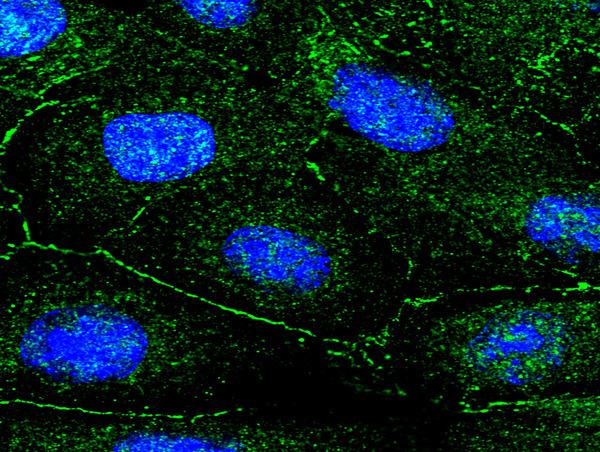


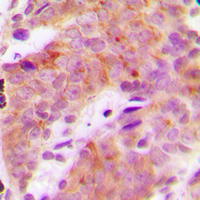
![ELISA analysis of antigen using GTX60550 p70 S6K antibody [5G9]. Black : Control antigen 100ng Purple : Antigen 10ng Blue : Antigen 50ng Red : Antigen 100ng](https://www.genetex.com/upload/website/prouct_img/normal/GTX60550/GTX60550_20170912_ELISA_w_23061123_750.webp)
